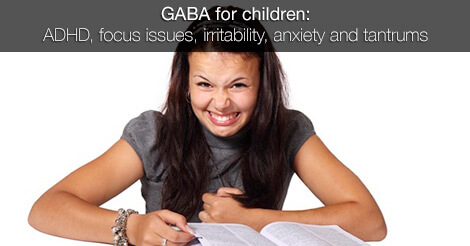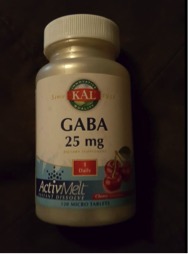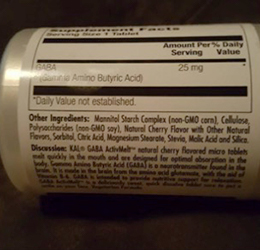
Is GABA safe for children with symptoms of ADHD? I was asked this question after my interview on anxiety on the Diabetes Summit. I shared the question and my answer on facebook:
I’ve used GABA (and theanine) very successfully with children with physical anxiety symptoms and ADHD. I’ve also used tyrosine for the attention/focus issues. Plus I always consider gluten, blood sugar control (animal protein at breakfast often makes the biggest difference), colors/additives, low iron, low zinc and candida (this list is not inclusive but is a good starting point)
Jenny is a mom in my facebook community and responded to the above post, sharing that a friend of hers recommended GABA for her daughter after reading some of my posts. She shared this wonderful feedback:
My daughter hasn’t been diagnosed with ADHD but has a lot of ADHD qualities. We were having a huge amount of behavior problems as she is getting older (she’s 11). I did some research and went to the health food store and bought a bottle. At this point I was mentally exhausted from all the fighting and drama at home and at school. I was desperate and didn’t want to put her on any hard medication.
She has had amazing behavior at school and at home since giving it to her. She’s almost like different child. GABA has truly changed our life. She’s been taking it for almost 2 months.
What wonderful results! I’m thrilled for Jenny and her daughter. I asked Jenny to share what her daughter’s symptoms/behaviors were before they used the GABA and which symptoms improved. This is what Jenny shared:
…before the GABA she was irritable, she was fighting with her teacher and schoolmates, she couldn’t focus and was distracted by anything and everything, she was constantly disrupting the class and she was throwing major tantrums over ridiculous stuff (like her hair didn’t do what she wanted), she was mouthy and everything was a fight.
We are not seeing 99% of those behaviors at all anymore. She of course is still your typical pre-teen but if I say “no you can’t have that” our “no you can’t go there” her reaction is OK. Before it would have been a major fight or meltdown. Her teacher is reporting to me every day about her wonderful days.
I love hearing this feedback and it’s not unusual for children to act out when they have low GABA levels. Adults may identify with being anxious, but children may appear irritable, unfocused and distracted, may have tantrums and meltdowns, and all the while not be able to articulate how they are feeling.
Long–term use of GABA and root causes of low GABA
Jenny also posed some additional questions about GABA:
I do have some questions – I can’t really find anything online saying that it’s OK to give to kids. I mean, I’ve seen the results but it still worries me. She takes one 25 mg pill a day – do you think that’s OK?? Should I give her more or less or keep it the same? Just wondering your opinion?
I shared some of this feedback on the facebook thread and have elaborated on it here on the blog.
There is no research on children and the long-term use of amino acids but plenty of clinical evidence showing they can be used safely for 3-12 months. But I am also always working with my clients to find out why there is the deficiency in the first place and addressing that. This could include any or all of the following:
- low zinc/vitamin B6/low iron which are all co-factors needed to make GABA (and then I’d want to know why are these low)
- dysbiosis, parasites and/or candida (we make GABA in the gut and we may have GABA-eating bacteria in the gut – such as gabavorous)
- too much stress at school, playing sports and/or at home
- not getting enough sleep
- not eating animal protein at breakfast (this affects blood sugar control and can stress the adrenals and impact cortisol, sex hormones and brain chemicals)
- gluten sensitivity (gluteomorphins in gluten can impact mood and gluten can damage the gut leading to nutritional deficiencies)
- low animal protein intake and/or eating a low-fat diet
- low stomach acid (so you can’t digest the protein you’re eating)
- toxin exposure (like pesticides or BPA)
- low total cholesterol (caused in part by low levels of enzymes for fat digestion or a low-fat diet)
I shared these 60+ Nutritional and Biochemical Causes of Anxiety on my closing call of the The Anxiety Summit season 3. I use this to help put the puzzle pieces together for my clients to resolve their anxiety and related issues like ADHD, insomnia, sadness, irritability etc.
When Jenny saw some of the root causes for low GABA she shared that she’s going to be making an appointment with her doctor. Keep in mind that in this instance it will need to be a functional medicine doctor or nutritionally trained doctor or a doctor who is open to learning about all this. I always also suggest taking a copy of my book The Antianxiety Food Solution to share with the doctor too!
What GABA product?
I typically have clients start with Source Naturals GABA Calm which contains 125mg of GABA. I was curious to know which 25mg GABA product she was using. It turns out to be a sublingual product by KAL.


You can find the other GABA products I use and recommend here and the precautions with using GABA here. Typically it’s an amino acid that has the least issues, unless too high an amount is used. I often hear that 500mg or 1000mg was used and caused dizziness or breathlessness – these are clues it’s too much!
As mentioned, one product I use and recommend is Source Naturals GABA Calm lozenges. It’s a good low dose of 125 mg and is convenient and effective because it’s a sublingual lozenge.
Now GABA Powder is another product I use and recommend. It does need to be measured out to provide a 125 mg typical starting dose or less (as needed). I have clients use a handy mini measuring spoon like this one (my Amazon link) and share more about how to measure out GABA powder on this blog).
For Source Naturals GABA Calm lozenges and Now GABA Powder:
- You can purchase these from my online store (Fullscript – only available to US customers – use this link to set up an account).
- If you’re not in the US, you can purchase these at iherb (use this link to save 5%).
Somnium GABA Cream is another option that could be considered especially for children and those with special needs. It is available in the US and elsewhere with international shipping. Read more about the product and who else may benefit from using a cream, and grab my coupon code to save 15%.
Why does GABA help in a situation like this?
These results are exceptional and it’s seldom just low GABA that needs to be addressed but in this instance it was. The low GABA type of ADHD is a bit different than low dopamine or low ferritin ADHD. With low GABA, it’s the anxiety that is causing the spinning, lack of focus, irritability and tantrums.
This blog post and study explains some of it – Oral GABA supplementation allows better prioritizing of planned actions: new research. GABA provides a better ability to handle tasks (complex and/or planned tasks) with less spinning and feelings of overwhelm, and prioritization of tasks is improved.
In addition to addressing low GABA, we also typically address the diet, gut health, toxin exposures (cosmetics are a big issue at this age), screen-time/EMFs (also a big issue at this age), and any other nutritional deficiencies.
Resources if you are new to using GABA as a supplement
If you are new to using GABA as a supplement, here is the Amino Acids Mood Questionnaire from The Antianxiety Food Solution (you can see all the low GABA symptoms).
If you suspect low levels of GABA or any of the neurotransmitters and do not yet have my book, The Antianxiety Food Solution – How the Foods You Eat Can Help You Calm Your Anxious Mind, Improve Your Mood, and End Cravings, I highly recommend getting it and reading it before jumping in and using amino acids on your own so you are knowledgeable. And be sure to share it with the team you or your loved one is working with.
There is an entire chapter on the amino acids and they are discussed throughout the book in the sections on gut health, blood sugar control, sugar cravings, self-medicating with alcohol and more.
The book doesn’t include product names (per the publisher’s request) so this blog, The Antianxiety Food Solution Amino Acid and Pyroluria Supplements, lists the amino acids that I use with my individual clients and those in my group programs.
If, after reading this blog and my book, you don’t feel comfortable figuring things out on your own (i.e. doing the symptoms questionnaire and respective amino acids trials), a good place to get help is the GABA QuickStart Program. This is a paid online/virtual group program where you get my guidance and community support. There are many moms in the program who are having much success with their kids.
If you are a practitioner, join us in The Balancing Neurotransmitters: the Fundamentals program. This is also a paid online/virtual program with an opportunity to interact with me and other practitioners who are also using the amino acids.
Have you noticed that your child (or even you personally) has seen improvements in these symptoms after using GABA: ADHD, focus issues, irritability, anxiety and tantrums?
Does it seem like it gives them (or you) a better ability to handle tasks (complex and/or planned tasks) with less spinning and feelings of overwhelm? Is prioritization improved?
If you are a practitioner are you seeing results like this with your clients/patients?
If you have questions please share them here too.
I asked Jenny if I could share here to give other mom’s hope and inspiration and practical results so they can help their children – and I really appreciate her being willing to do so.
Thanks for sharing Jenny! Happy mama and happy daughter – it warms my heart to hear stories like this!